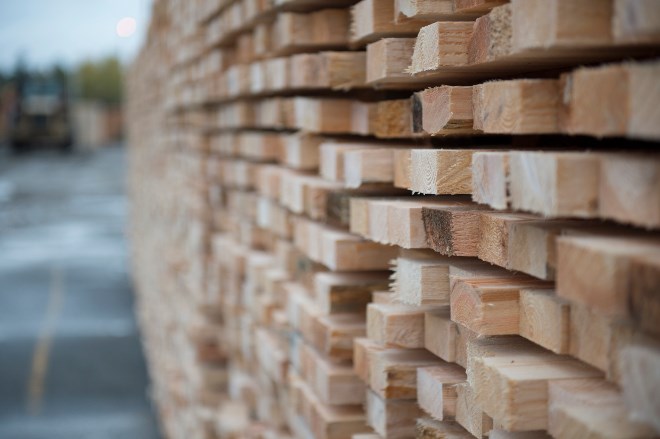Ignore the noise.
That’s what Derek Nighbor is taking away from his many conversations with federal bureaucrats and industry leaders concerning the ongoing softwood lumber dispute.
“We respond to what the U.S. does, not to what the U.S. says,” said the CEO of the Forest Products Association of Canada, in echoing an often repeated line from federal Natural Resources Minister Jim Carr.
“It’s a fine line to being vigilant, monitoring and focusing on what we can control. We’ll get whiplashed if we respond to every word that comes out of Washington these days.”
Nighbor had high praise for Ottawa’s $867-million package, announced June 1, to aid forest products exporters hit with U.S. countervailing duties of about 20 per cent. A second anti-dumping duty is expected to be imposed June 23.
During the last cross-border dispute in 2006, the Paul Martin government attempted to deliver relief but the damage to the industry from duties had already been done.
Nighbor, whose association helped shape the relief package, praised the Trudeau government for acting quickly with a “robust response.”
The comprehensive aid program, he said, “checks of all the boxes” in making appropriate investments in the right places to help large and small mill operators.
It involves loans and loan guarantees from the Export Development Canada (EDC) and the Business Development Bank of Canada, which will be coordinated with provincial programs to backstop the wood sector. Ontario’s response has been a $20-million funding boost for forest access roads.
Loans will be available for companies to diversify product lines, make inroads into new overseas markets, help Indigenous parties improve their participation in forestry, and to extend work-sharing agreements from 38 to 76 weeks to minimize layoffs.
The details of the program and eligibility requirements will be rolled out by Export Development Canada over the next few weeks.
Through his conversations with the agency, Nighbor said EDC has formed a special internal team to field calls and questions from mill owners on program specifics and eligibility requirements.
As expected, the U.S. Lumber Coalition (the influential lobby group that triggered the initial countervailing duties in April) called Ottawa’s aid program another subsidy that “further tilts the trade scale in Canada’s favor.”
Nighbor believes the package is should pass the legal sniff test when the dispute reaches the final determination phase, likely in January.
“We’re very confident the government has done this responsibly so as to avoid any further trade risk, retaliation or further countervailing duties for the U.S.”
Nighbor said Ottawa needed to be “trade sensitive” to ensure they were not providing direct loans to cover payments of duties. “But there are other ways that they could support through bonds – to support electricity payments on a quarterly basis – or term loans for other things. There is a host of other operational or export-related things that they can help with.”
Nighbor said the package mirrors the changes happening in a sector that’s moving into new value-added products and is exploring new export opportunities in China, India and the Middle East.
“This is an industry that is innovating into biomaterials, biofuels, and mills are becoming mini power plants in many communities. The ongoing diversification into new product areas is important. We’re not going to turn every saw mill into a biofuel facility, but we’re seeking those opportunities where it makes sense to diversify the products we’re making.”
That’s why government market and product innovation dollars are so important, he acknowledged.
The current lumber dispute between the U.S. market-based system and the provincial fee-based structure has been part of a legacy that’s been ongoing for decades without any final resolution. The latest softwood agreement expired in October 2015.
But the timing this tussle coincides with the Trump administration’s determination to renegotiate NAFTA. Whether a lumber trade deal becomes part of those discussions hasn’t been determined.
“From our perspective, we’re keeping all options on the table,” said Nighbor. “The questions we’re getting is do you want softwood in or out of NAFTA? At this point, it really doesn’t matter where it is as long as we deal with it.
“There’s a reason why softwood and supply management were in not in NAFTA in the first place. They’re tough.”
On the bright side, Nighbor said he’s heartened by the “Team Canada approach” shown by business leaders, federal and provincial politicians of all stripes who are putting on the “charm offensive’ to talk trade at the state level.
“Those governors and state governments are going to be really important as we go down the NAFTA conversation.”
Further support has come from south of the border through homebuilder, retailer, and consumer groups.
“The U.S. can only satisfy three-quarters of its domestic demand,” said Nighbor, who expects to be meeting a delegation of U.S. homebuilders in Ottawa in late June. With single-family home construction there on the rise, there should be an even greater demand for Canadian lumber this year, he said.
The Washington-based National Association of Home Builders said uncertainty over the lumber trade deal stands to increase the price of a new home by almost US$3,600. “It’s basically going to drive up the cost for a product they need and want,” said Nighbor.
“This is a loser for U.S. consumers.”




